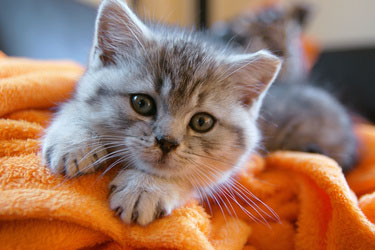Veterinarian Tips: Translating a Cat’s Meow!

Using techniques they learned as kittens, cats communicate through a series of meows and vocalizations. While not all cats are as talkative as others, becoming familiar with their talking patterns is important. A cat owner that pays attention may pick up on a vocalizing difference that could indicate a problem that needs to be looked at by the veterinarian.
To inform cat owners how to discern symptoms through their cat’s vocalizations, provide them with the following information.
Stages of Feline Communication
Kittens
When a kitten communicates, it is attempting to express a basic need.
Depending upon the sound, the kitten is probably calling for its mother to let her know that it is cold, hungry, or feeling insecure. As it gets older, it learns that its calls will quickly bring the attention of the mother or the caregiver.
If ever a kitten is crying loudly with a different type of vocalization, it should be treated as if in pain and taken to the veterinarian immediately.
Adults
Adult cats have their own repertoire of vocalizations and, similar to kittens, they communicate to let their person know that they needs something!
Increased vocalization could be the cat’s way of communicating the following information:
- Need for attention. Some cats have a specific call when they are searching for their human or their animal companion
- Feeling threatened. Perhaps caused by seeing a strange cat or dog from the window or in the yard
- Warning. Cats have been known to alert families to such dangers as:
- Fire
- Gas leak
- Severe storm
- Someone trying to break into the home
- Grief, caused by:
- Loss of a companion
- Favorite family member moved out
Feeling of uncertainty. Caused, for example, as a reaction to things occurring within its home, such as:- Packing up and moving into a new house
- The addition of a new pet or human to the home
- Changes caused by remodeling or moving furniture around.
Time to Call the Veterinarian
Pain and Illness
Cats can be very stoic when it comes to pain. In general, owners should be observant for changes that could indicate the following signs of illness or pain:
- Crying continuously
- Normally quiet cat suddenly becomes very vocal
- Normally talkative cat suddenly stops talking.
Also, a cat that had been continuously crying but has suddenly stopped may have developed a case of laryngitis and should still be taken to the vet.
Seniors
When an older cat starts to uncharacteristically pace and cry loudly, it may be suffering from a condition known as cognitive dysfunction syndrome (CDS).
When first diagnosed, many owners indicate that they have observed the animal experiencing problems with its memory, such as forgetting to use the litter box or seeming confused when in the home. As the condition develops, the symptoms appear similar to those of dementia.
The loud crying occurs because the animal feels anxious and confused.
Categories of Cat Vocalization
When communicating with each other or with their people, cats have different categories of sounds.
- Purring is believed to occur when the animal is happy. However, cats who are sick, in pain, or dying are also known to purr. Purring creates a type of rumbling vibration that can be felt when petting the animal
- Meowing is usually done in an attempt to communicate what they need, for instance:
- Feed me!
- Open the door!
- Pet me!
The tone and the frequency of the meow can point to the animal’s mood, for example:
- A longer meow may signal annoyance or displeasure
- Repeated meows may indicate pain or illness
- A soft, low meow may signal happiness
Yowling sounds like a human scream. Cats that yowl may be:- Angry
- In pain
- In heat and ready to mate
- Trying to scare off a rival over territory
- Chirping. Cats are often observed to chirp when they are excited, such as when they are watching birds.
- Hissing. A hissing sound is a sign that the animal is frightened or upset. It is typically accompanied by other warning signs such as:
- Ears pinned back
- Arched back
- Growling. A cat’s growl is a warning that it wants to be left alone. When petting the cat, if it repeatedly growls when a certain area is touched, it could be a signal the animal is in pain.
- Crying and whining. When a cat cries, it sounds similar to a dog’s whine. It’s thought to be a way to communicate distress
- Caterwauling sounds like a short, shrill yell. It occurs during mating times by both females and males.
Call To Action & Close:
Offer this information to cat owners, particularly new cat owners, so they may be alerted to its injury or illness. Cat owners may be amazed at what they can learn by simply paying attention to their pet as it attempts to communicate!
Sources:http://www.cathealth.com/how-and-why/how-to-translate-cat-talk
http://m.petmd.com/cat/slideshows/8-cat-sounds-and-what-they-mean
Careers
Are you looking for a place to let your talents shine? At Covetrus, we help our practitioner customers better serve their patients and take pride in providing the best customer experience possible. Search our open positions to see our available opportunities.
Newsletter
Stay current with what’s going on with Covetrus, subscribe to receive our newsletter and email communications. Subscribers will receive the latest information in practice management, sales and marketing, animal health, and more.


Leave a comment